“For the Great Father is angry, and will certainly hunt them down…”: Native American Wars Against United States Expansion
This is the third in a series of blog articles highlighting primary source content from the Readex Native American Tribal Histories collection. The articles in this series offer further insight and added perspectives into westward expansion, the Trail of Tears, the history of Manifest Destiny, and the impacts to Native Americans.
As the United States claimed more territory in North America, it displaced Native American nations, many of whom were moved farther west or to Oklahoma as part of a governmental policy of “Indian removal.” Repeated treaties whittled away at Native American territories, while changing borders, land runs, and white settlers’ disregard for Native territorial boundaries increased tensions. Many Native groups resisted with military force, and while Indian agents and government officials frequently expressed disdain for Native American war tactics, they were formidable opponents. One such war began in Colorado in 1864.
Organized as a territory in 1861, the dry, mountainous lands of Colorado were originally viewed by settlers and prospectors as less desirable than the green valleys of the West Coast or the gold fields of California. But when gold was discovered in the region, miners and settlers swiftly poured in and soon clashed with Native Americans already living there.
Writing to William P. Dole – then Commissioner of the Bureau of Indian Affairs – in April of 1863, Territorial Governor John Evans complained of,
...threatened hostilities by the Arapaho and Cheyenne Indians under his [Major John Loree’s] agency on account of their being neglected and misunderstanding the treaty of the Upper Arkansas of 1861… Unless this difficulty is at once adjusted we are liable to have a bloody Indian war upon our hands. Depredations have already commenced and troops have been sent on the Cache Le Poudre to protect our settlements.[i]
While Evans claimed the Cheyenne and Arapaho had misunderstood the terms of the 1861 treaty, Samuel Browne in the U.S. Attorney’s office wrote in March 1863,
The Boone treaty does not define the land ceded and of course the lines must be fixed by your department, I am inclined to think that we would have trouble with the Arapahoes [sic] [illegible] of the Southern Platte if the government sought to take their lands without a treaty and suggest the propriety of appointing a Commissioner to treat with them. We can make a treaty without any difficulty and by doing so avoid all future troubles. In the mean time the lines as defined above and as claimed by the Indians should remain as the boundaries of the cession.[ii]
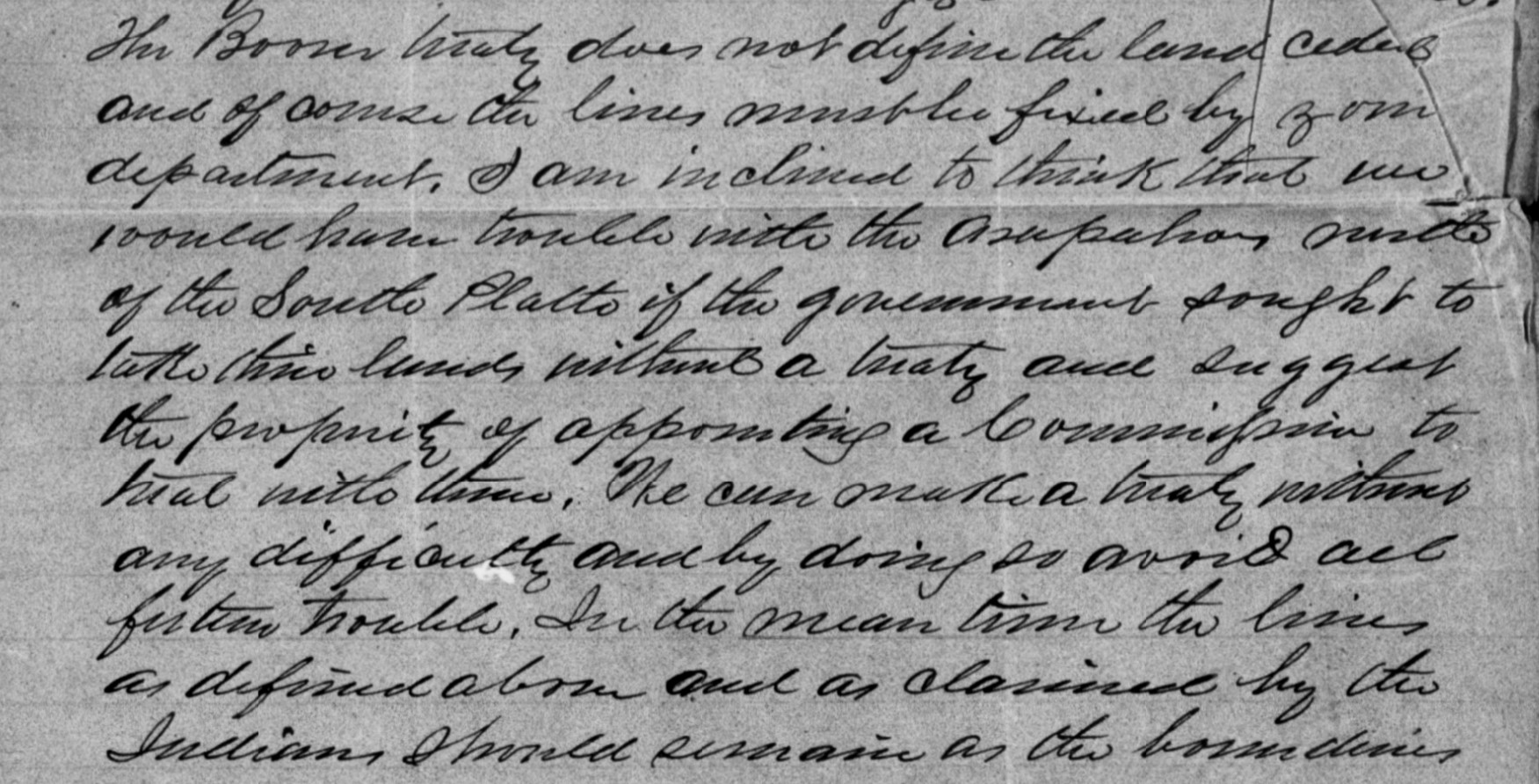
Evans, on the other hand, was
...confident that last Fall these bands of Indians and in fact the whole of the Cheyenne and Arapaho tribes might have been induced to accept under the treaty had proper notice been given to them. They now claim nearly all of the country that is of special value including its rich mines and the best of its agricultural lands in Colorado. And from Maj. Loree and others I learn that they are preparing to drive the settlers from their claims on the North and West Side of the South fork of the Platte river. They are now busy in negotiating with other tribes and especially the Sioux under Maj. Loree’s Agency to induce them to join them in the effort to drive the whites off of what they claim to be their lands and which involves almost all of the mining interests.[iii]
Indeed, Governor Evans blamed Browne’s opinion letter for exacerbating the situation. Evans worried,
If this be the true state of the case then have the people of Colorado been grossly mistaken as to their position and rights under the treaty with the Arapahois [sic] and Cheyennes. Then by the Organic Act we are without any Territorial Authority excepting over the City of Denver and a few agricultural settlements of small population on the south side of the Platte… [iv]
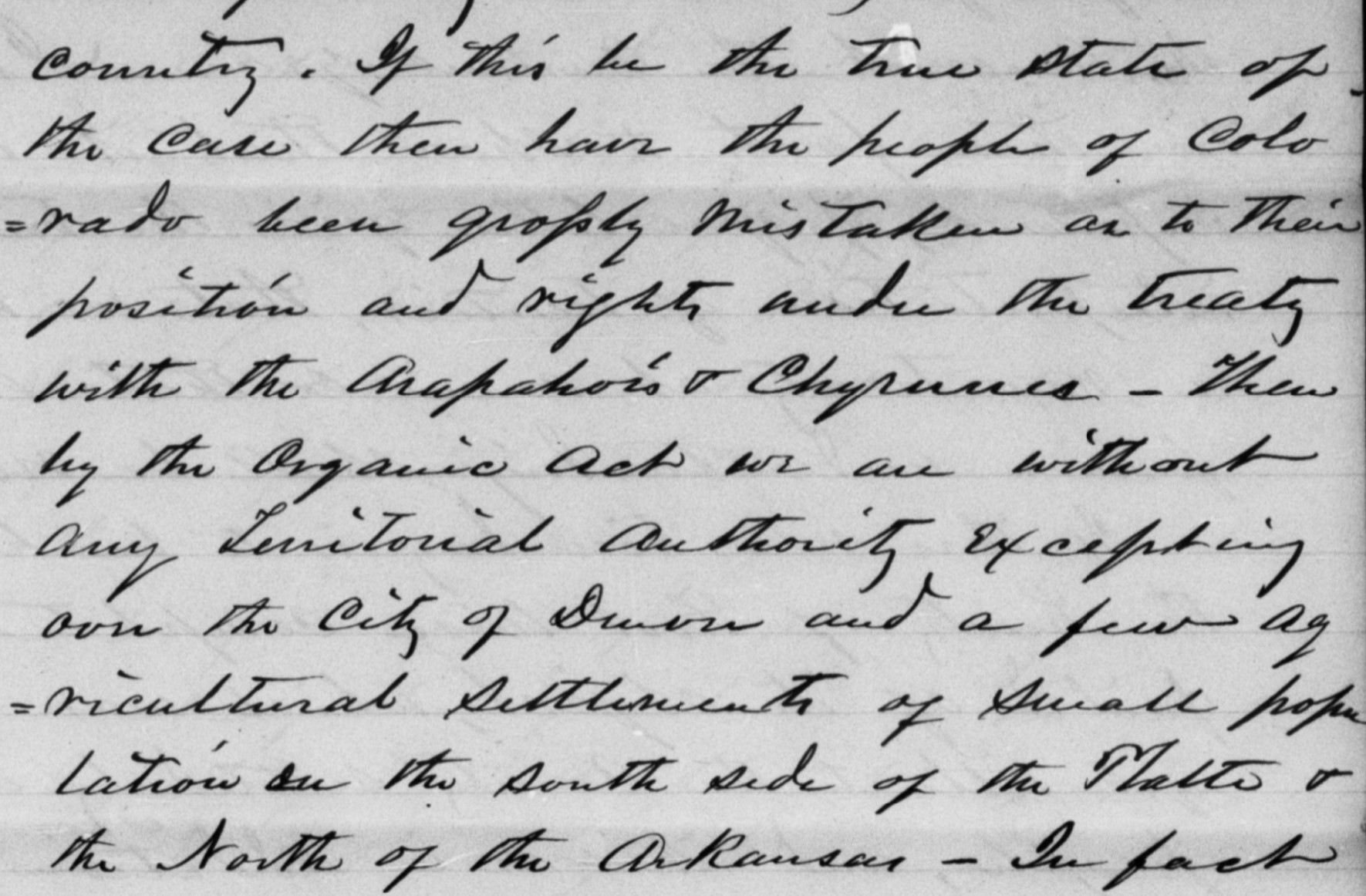
According to the treaty, most of the profitable gold mines of Colorado would fall outside the control of the territorial government, and the Cheyenne and Arapaho would be within their rights to expel the miners. Both Evans and Browne believed a new treaty would solve the issue, and Evans closed his letter:
I beseech you in the name of humanity and of our dearest interests to give me authority to avoid this threatened repetition of the Minnesota War, it may be on a larger and more destructive scale.[v]
Evans wrote to Dole again on July 17, 1863 to inform the Commissioner of his plan to meet with Cheyenne and Arapaho leaders on September 1. Evans hoped to convince them to accept the 1861 treaty, or
...what modifications will satisfy them: being careful to discourage the making of demands on their part that cannot be conceded by the Commissioners.[vi]
The Tribal leaders did not attend the September council, and Evans was disappointed:
...the effort to secure a general council of the bands of Arapaho and Cheyenne Indians who were not parties to the Treaty of Fort Wise failed yet… we hope yet to secure all of those contemplated in the additional instructions of the Secretary of the Interior on the terms and conditions herein prescribed.[vii]
As the year wore on, the governor made more attempts to secure a treaty, with the same results. A letter from Major John Loree on October 24, 1863, warned:
I met Antoine Jamise and Joseph Laravie one of the scouts that had been north of Powder river [Cache la Poudre]. They stated there was an influence working against the making a treaty with the Cheyennes at this time about Deer Creek. In counselling with the Indians they told me with great hesitation that some of the old traders had advised them not to treat this winter, that they could do better next Spring. They could get heap horses and big treaty.[viii]
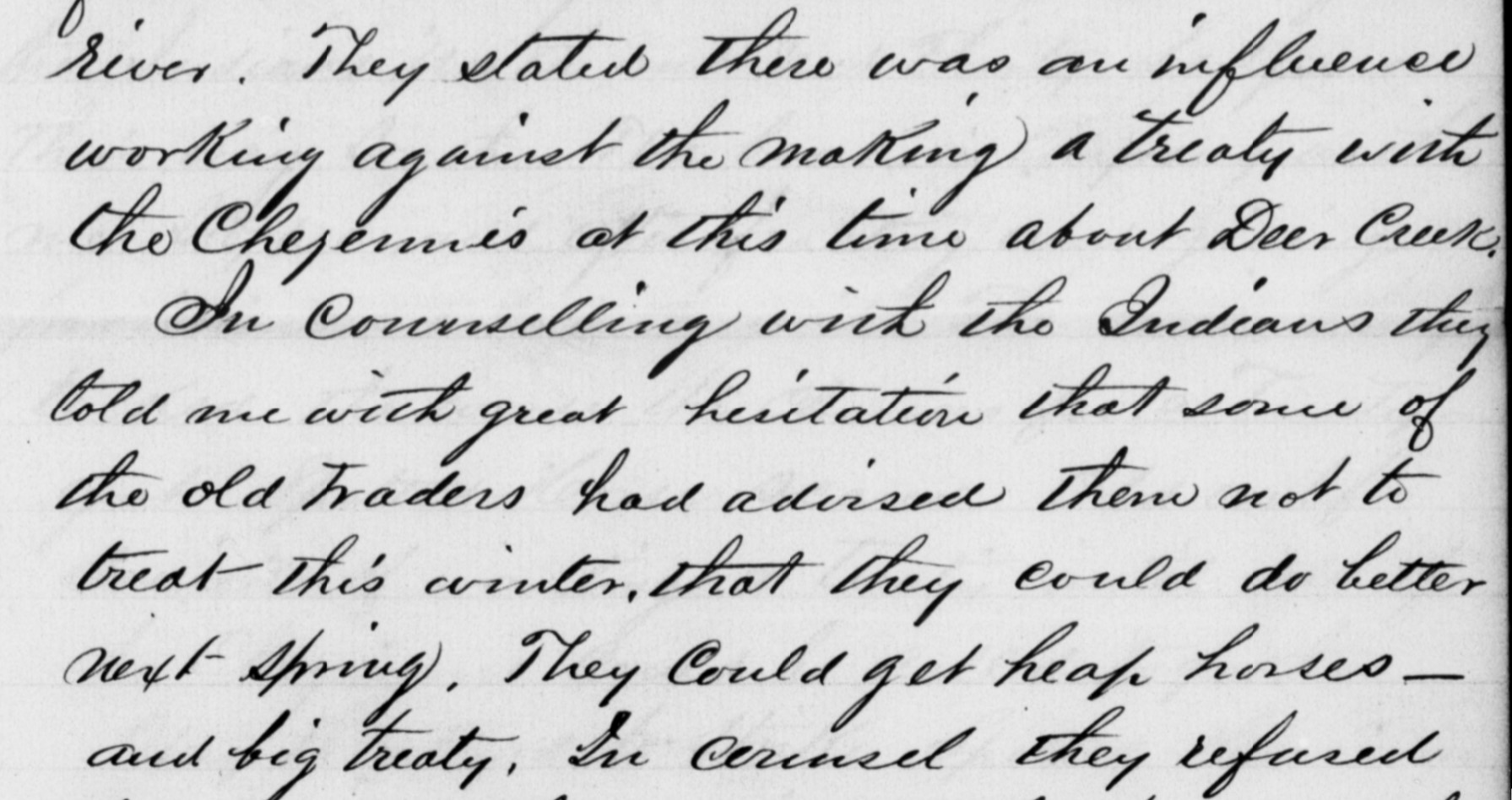
On November 9, Evans wrote:
I have to-day met Roman Nose and two or three of his Minor Chiefs of the Arapahoe [sic] tribe who profess friendship themselves but say that there is a hostility and a disposition to go to war on the part of the Cheyennes [sic] Sioux and Kiowas. He promised to remain friendly and true to the whites but declined to enter into the Treaty we had designed for them under instructions from the Department until he could get his whole band together.[ix]
While Evans believed Roman Nose’s reluctance was because he was “in league with the parties preparing for war,”[x] it is important to note Roman Nose was not a chief but a prominent warrior of the Cheyenne, and may have felt he had no authority to make a treaty with Evans. One of the objections the Cheyenne had to the 1861 treaty was it had not been endorsed by the majority of the tribe. Although Loree believed the traders were to blame for the reluctance of the Cheyenne to make a treaty, they were also likely aware of Evans’ dubious authority to make deals with them.
On November 11, the governor wrote to Dole:
I have the honor to report a conference with the Chiefs of the Northern Band of Arapahoes [sic] held this day. They peremptorily demand a reservation on the Cache la Poudre as the only condition on which they will talk of a treaty. I told them that I would go to Washington and talk the matter over with you and tell them on my return the result. This seemed to please them and they promised to come and see me on my return.[xi]
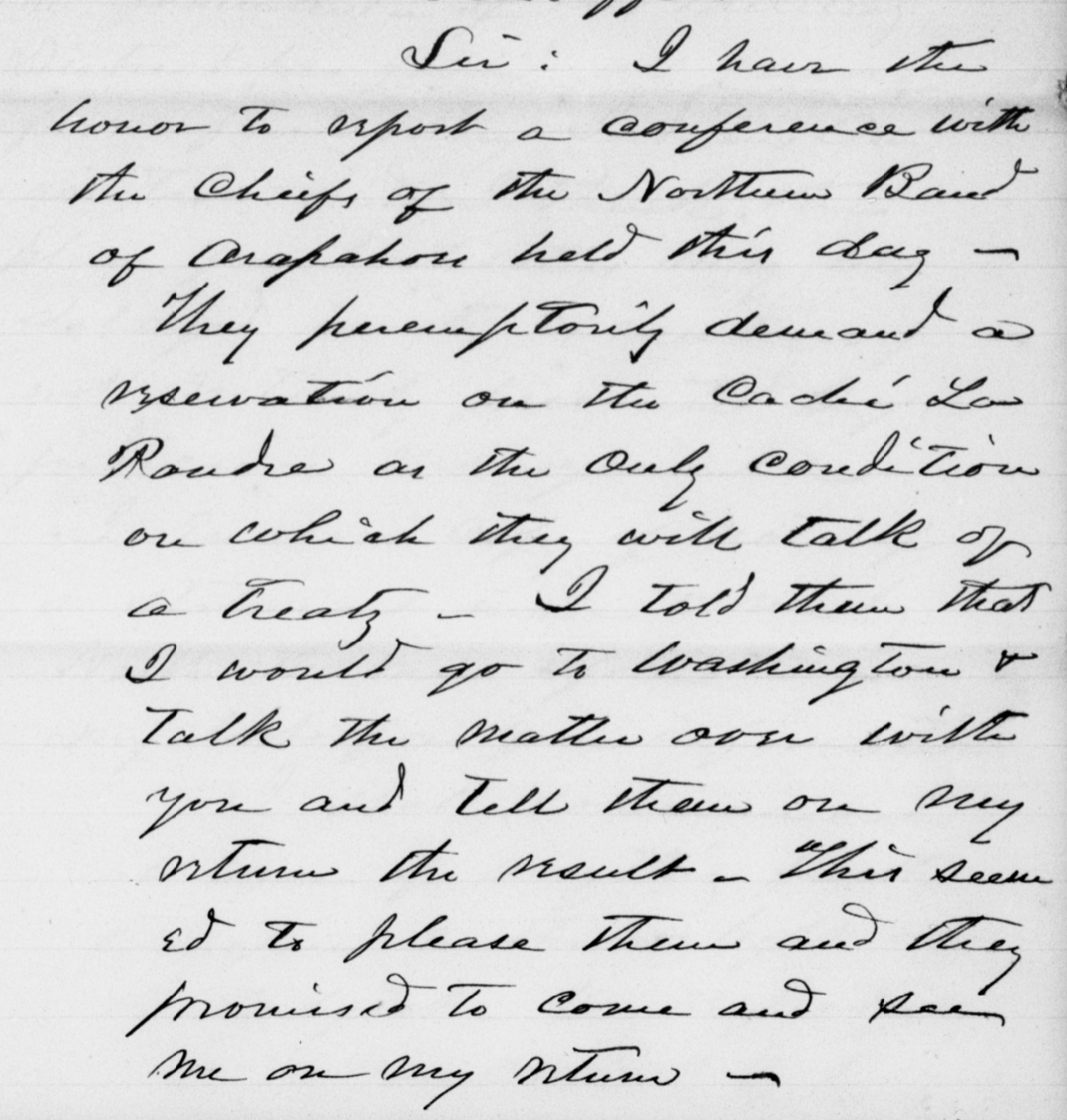
The Arapaho leaders also agreed to pay for any livestock they had killed and to leave the area, but given Evans’ reluctance to meet their demands, they must also have been aware of the governor’s tenuous authority for treaty-making. Indeed, Evans again wrote to Dole in late December of 1863 and asked permission to meet with the Cheyenne and Arapaho to find an alternate settlement to the one on the Arkansas river “which they utterly refuse to occupy.”[xii]
Despite Evans’ efforts to enforce an interpretation of the treaty which would be more favorable to the United States, Native raids continued into the winter and the governor continued to worry about a widespread war. His fears were soon confirmed and in early November 1863, a letter was forwarded to Evans from a local interpreter, who wrote,
My long acquaintance with the Indians enables me to judge of their disposition and I can safely say that there is great danger of hostilities from them. This view is strengthened by the presence on the Arkansas of a large band of Sioux Indians and another on the Smokey Hill – who have never been so far South before – who are said to be offering the war pipe to the different tribes that frequent the Arkansas and Smoky Hill Fork Country. This information I have recently received from the leading men of the Arapahoe [sic] Kiowa Comanche and Apache Tribes.[xiii]
Another report from a man named Robert North who claimed to have lived with the Arapaho since boyhood warned,
I saw the principal Chiefs pledge to Each other that they would shake hands and be friendly with the Whites until they procured Ammunition and guns so as to be ready when they strike. Plundering to get means has already commenced and the plan is to commence the war at several points in the sparce [sic] settlements early in the Spring.[xiv]
He also cautioned,
There are a great many Mexicans with the Camanche [sic] and Apache Indians all of whom urge on the war promising to help the Indians themselves, and that a great many more Mexicans would come up from New Mexico for the purpose in the Spring.[xv]
The Cheyenne, Arapaho, Kiowa, Comanche, and the Sioux had made an alliance against the settlers in Colorado, and if they were receiving aid from Mexican forces, Evans and the Colorado Territory were facing serious problems. The Native groups knew they held an advantage. A letter from Major John Loree warned, “The Cheyennes say that the Whites are all at war in the States and that they will Kill one another and the Indians will take this Country in the Spring.”[xvi]
As the Civil War gained momentum and troops from Colorado were sent east, Evans complained,
…we are far more defenceless [sic] than Kansas, and at the same time infested with Guerillas who are committing extensive depredations, and that we protest against being left thus defenceless [sic] against Guerillas and Indians six hundred miles away from assistance of protection that our troops may defend the settlements in Kansas from the same parties.[xvii]
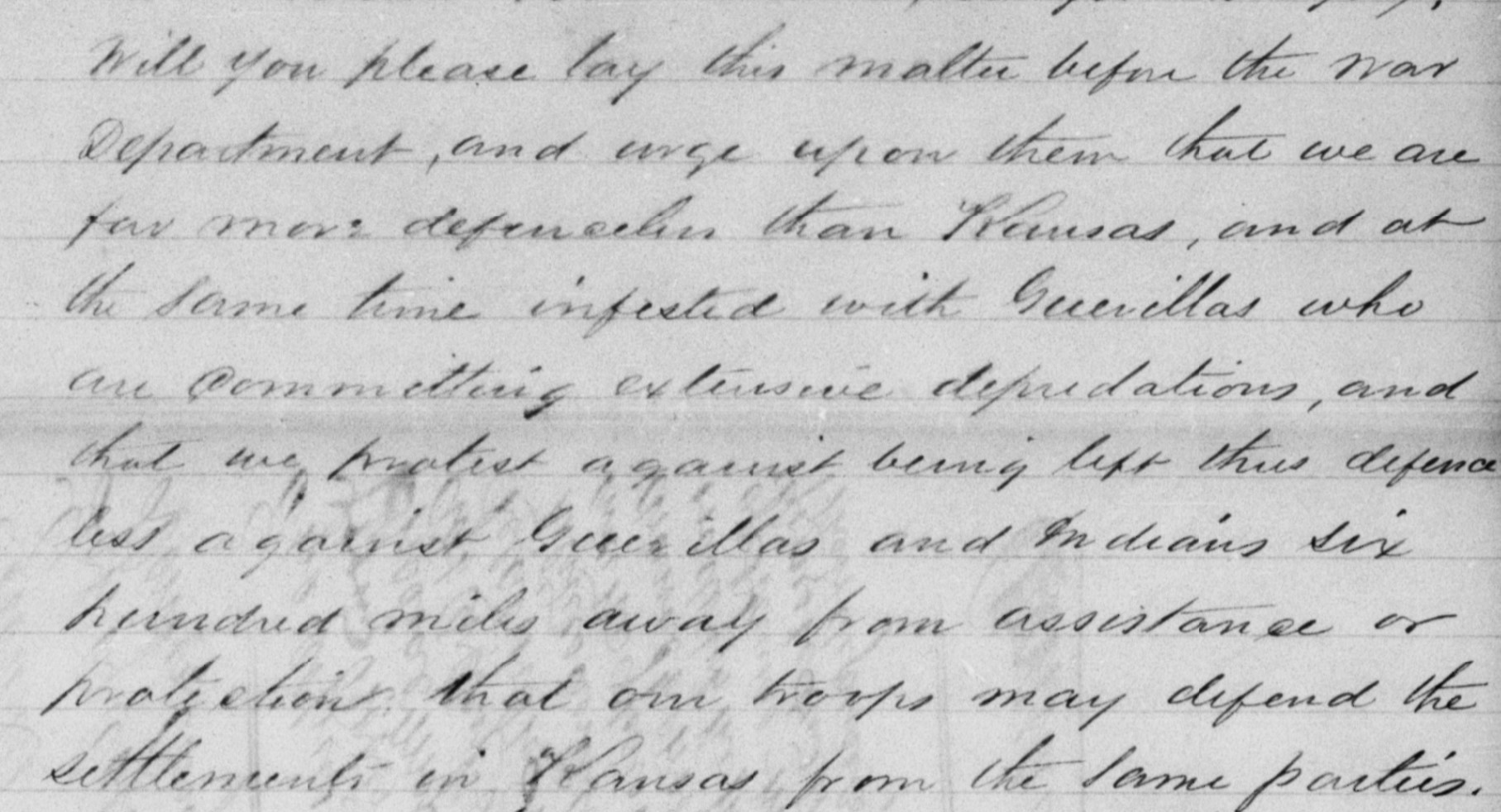
Although Colorado’s territorial government was compromised by resources allocated to the Civil War, the war bands were still faced with an enemy which possessed more resources and a large, dedicated army, and Native Americans did not often engage in the sort of pitched battles recognized by whites as legitimate warfare. While large engagements like the Battle of Little Bighorn did occur during Native American wars against the United States, many Native groups instead used tactics similar to guerilla warfare; raids against settlements and travelers were common, and Native fighters stole horses for their own uses or drove off livestock and stole supplies.
Letters and reports trickled into Governor Evans’ office from spring 1863 through the following year. In June of 1864, Robert North – a special messenger employed by local agents – reported:
The Cheyennes moved their families to the salt mines (salt plains) on the Cimerone creek. Their plain [sic] is to run their plunder off to Cimerone where their [sic] is good Buffalo hunting. They will keep the stock at the salt plains or those Mexicans who are in alliance with them will run them off to New Mexico.[xviii]
While there was little evidence to support such claims, Evans’ correspondence to William P. Dole grew increasingly alarmist, and on August 10, 1864, he warned,
I am now satisfied that the tribes of the plains are nearly all combined in this terrible war as apprehended last winter it will be the largest Indian war this country ever had extending from Texas to the British line involving nearly all the wild tribes of the plains…[xix]
Depredations and raids continued, but the promised Mexican reinforcements had apparently not materialized, and Evans did not report any large-scale raids or actions by the Native forces. Nevertheless, the governor continued to push Dole for more troops and guns.
Meanwhile, Governor Evans also made overtures of peace to the Native tribes in the area. On June 27, 1864, he wrote a “Proclamation to the Friendly Indians of the Plains,” which directed agents and interpreters to,
...inform the friendly Indians… some members of their tribes have gone to war with the white people. They steal stock and run it off hoping to escape detection and punishment. In some instances they have attacked and killed soldiers and murdered peaceable Citizens. For this the Great Father is angry, and will certainly hunt them down and punish them.
He further instructed friendly bands to gather at Fort Lyon and Fort Larnet:
...to prevent friendly Indians from being killed though mistake. None but those who intend to be friendly with the whites must come to these places. The families of those who have gone to war with the whites must be kept away from among the friendly Indians.[xx]
These overtures were apparently successful, and many groups of Cheyenne and Arapaho gathered as instructed. As friendly Native tribes gathered near U.S. forts and the war bands lost political and material support, the war may have simply lost momentum. But on the morning of November 29, 1864, the First Cavalry and the Third Regiment of Colorado, led by Colonel John Chivington, attacked and massacred a group of peaceful Cheyenne and Arapaho camped near Fort Lyon at Sand Creek. While Black Kettle and other leaders of the group raised an American flag and a white flag of surrender to the soldiers, Chivington and his men continued to attack, and “about one hundred and fifty men, women, and children, [were] killed, scalped, and mutilated in the most horrible and disgusting manner…”[xxi] While Chivington and his men were later defended by some writers as having done what they thought was best to end the war, their monstrous actions were ineffective.
The Colorado War dragged on until August 25, 1865, when a truce between the Apache, Comanche, Kiowa and the United States was agreed.[xxii] A treaty was signed in October.[xxiii]
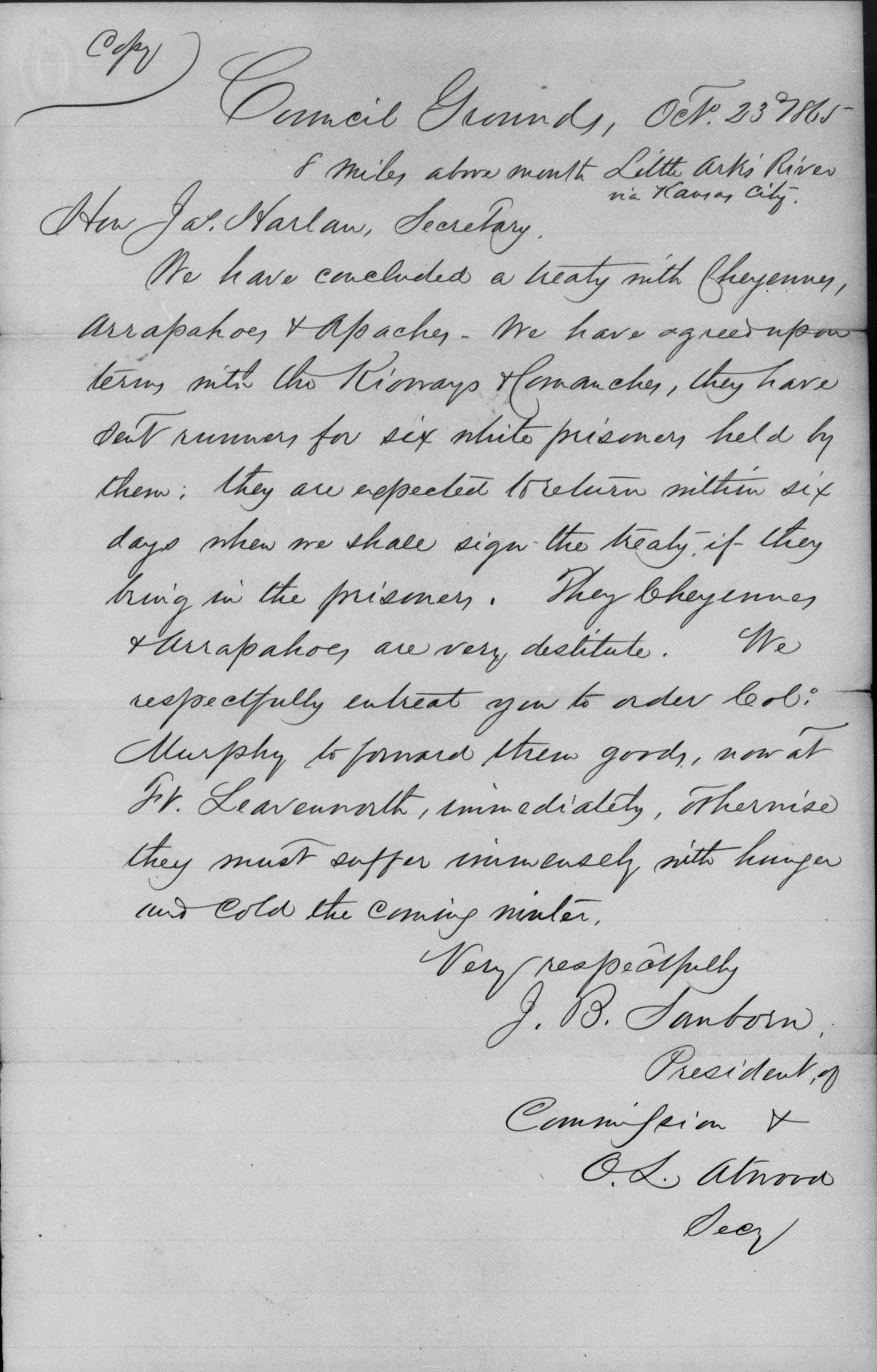
Wars between Native American nations and the United States would continue, and so too would massacres like Sand Creek.
[i] [Letter from John Evans to William P. Dole, April 10, 1863]
[ii] [Letter from Samuel E. Browne to J.P. Usher, March 16, 1863]
[iii] [Letter from John Evans to William P. Dole, April 10, 1863]
[iv] Ibid.
[v] Ibid.
[vi] [Letter from John Evans to William P. Dole, July 17, 1863]
[vii] [Letter from John Evans to William P. Dole, Sept. 22, 1863]
[viii] [Letter, with Correspondence from John Loree, from John Evans to William P. Dole, Nov. 4, 1863]
[ix] [Letter from John Evans to William P. Dole, Nov. 9, 1863]
[x] Ibid.
[xi] [Letter from John Evans to William P. Dole, Nov. 11, 1863]
[xii] [Letter from John Evans to William P. Dole, Dec. 20, 1863]
[xiii] [Letter from John Evans to William P. Dole, Nov. 9, 1863]
[xiv] [Letter from John Evans to William P. Dole, Nov. 18, 1863]
[xv] Ibid.
[xvi] [Letter, with Correspondence from John Loree, from John Evans to William P. Dole, Nov. 4, 1863]
[xvii] [Letter, with Reports, from John Evans to William P. Dole, Aug. 9, 1864]
[xviii] Ibid.
[xix] [Telegram from John Evans to William P. Dole, Aug. 10, 1864]
[xx] [Letter from John Evans to William P. Dole, June 30, 1864]
[xxi] [Letter from Samuel Forster Tappan to Charles Sumner, April 10, 1865]
[xxii] [Letter from George C. Tichenor to Dennis N. Cooley, Aug. 25, 1865]
[xxiii] [Letter from J.B. Sanborn to James Harlan, Oct 23, 1865]
Other blogs in this series:
- Part 1: Native Removal Prior to the Indian Removal Act of 1830
- Part 2: Nineteenth Century Treaties with Native American Nations
Visit the Readex Native American Tribal Histories page for information on this collection and to request a complimentary trial.



